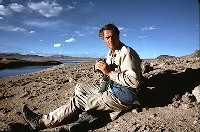2018 School Spending Survey Report
Life in the Wild
 Biologist, ecologist, and photographer George Schaller has hope that his images of wild creatures in Life in the Wild: George Schaller's Struggle to Save the Last Great Beasts (Farrar/Melanie Kroupa Bks, 2008) will inspire a new generation to protect the earth. We spoke with him in between his recent travels. What do you think young people will respond to in the book? It's about animals that everybody can relate to: pandas, and tigers, and so forth. And that automatically creates interest and empathy because after all, conservation comes from the heart. If you can stimulate people emotionally, you will help conservation. Also, it shows photographs of my wife and children, which makes children aware that when they grow up they don't have to settle down. They can go to wild, beautiful places with their whole family. We lived for over three years among lions in the Serengeti, and we lived with tigers in India. Children learn just by observing there are different kinds of life. It's not just American culture. Other cultures are fascinating and unique. Each country offers something that's worth considering. And children absorb that. What can young people do to help conservation? Certainly one of their jobs is to educate their parents—and to keep the interest. All children are interested, and then when they become teenagers they often lose it completely because of peer pressures and so many other things in their daily lives. But every community usually has some sort of small environmental organization whether it's a land trust, the Audubon Society or something. You don't have to go study pandas. You can be concerned about the environment in your own community, but you should also be concerned about the environment in the rest of the world because everything is connected. How can teachers, parents, and librarians help encourage young people in these pursuits? This country wastes a huge amount of good, fresh water by simply not thinking about it, just being careless, or not paying enough for what we use, such as in irrigation. We can have kids in schools learning that every act is an ecological act, whether drinking a cup of water, turning on a light switch, eating a steak, or cooking a steak. Everything has an environmental impact either directly or indirectly, and that, at least, makes them conscious of it. And I think it's the schools that need to do it, because the media is almost hopeless. They want sound bites, they don't want complex issues. Even the nature shows seldom talk about anything in conservation. And they don't stimulate people to action. They show pretty pictures that are almost virtual reality. And that's a serious concern because kids watch a lot of these and they're not stimulated to action because of poor scripts. How do environmental issues play in this upcoming presidential election? Before you vote for anybody in public office you should look at their record. And that includes the environment. We've had eight years of environmental destruction in this country. The public has basically shown apathy. Now there is considerable concern about climate change and that is the first time the public has really been aware of environmental problems that they have to think about. And parents when they see these things can discuss it with their children and encourage them to become locally involved. When did photography start to play a part in your work? I had a little box camera when I was still in high school, went to Canada, and took some pictures of porcupines and great blue herons and things like that. It wasn't until later that I realized that if you had a good, interesting photo, someone might buy it. But I've always been aware since my college days that your research has to reach the public. Which means writing articles for magazines, and for that you need photos. Is there one thing you're most proud of in your career? The most lasting impact, and one I've been particularly concerned about in recent years, is training young biologists in their own countries, whether it's China, Afghanistan, Mongolia, or wherever I work, to show them what can be done, help them get into universities, help them get degrees, and help them to get funding so that they can continue to work in their own countries. They are they ones that are responsible for the future of a healthy environment and livelihood of their people. What are you focused on now? I have a nature project in China, in Tibet, where we are working with the nomads out on a high plateau. Most of it is at 15,000, 16,000 feet. They're livestock herders and we're trying to see about their livelihood and also about the wildlife around them, whether it's wild yak or Tibetan antelope, and that's a long-term project. The Peace project is another project I'm working on. It's in the Pamir Mountains, which cover parts of Tajikistan, Afghanistan, Pakistan, and China. We're trying to get the four countries to cooperate in protecting the wildlife, rangeland, and the livelihood of the local people and these are all long-term things.
Biologist, ecologist, and photographer George Schaller has hope that his images of wild creatures in Life in the Wild: George Schaller's Struggle to Save the Last Great Beasts (Farrar/Melanie Kroupa Bks, 2008) will inspire a new generation to protect the earth. We spoke with him in between his recent travels. What do you think young people will respond to in the book? It's about animals that everybody can relate to: pandas, and tigers, and so forth. And that automatically creates interest and empathy because after all, conservation comes from the heart. If you can stimulate people emotionally, you will help conservation. Also, it shows photographs of my wife and children, which makes children aware that when they grow up they don't have to settle down. They can go to wild, beautiful places with their whole family. We lived for over three years among lions in the Serengeti, and we lived with tigers in India. Children learn just by observing there are different kinds of life. It's not just American culture. Other cultures are fascinating and unique. Each country offers something that's worth considering. And children absorb that. What can young people do to help conservation? Certainly one of their jobs is to educate their parents—and to keep the interest. All children are interested, and then when they become teenagers they often lose it completely because of peer pressures and so many other things in their daily lives. But every community usually has some sort of small environmental organization whether it's a land trust, the Audubon Society or something. You don't have to go study pandas. You can be concerned about the environment in your own community, but you should also be concerned about the environment in the rest of the world because everything is connected. How can teachers, parents, and librarians help encourage young people in these pursuits? This country wastes a huge amount of good, fresh water by simply not thinking about it, just being careless, or not paying enough for what we use, such as in irrigation. We can have kids in schools learning that every act is an ecological act, whether drinking a cup of water, turning on a light switch, eating a steak, or cooking a steak. Everything has an environmental impact either directly or indirectly, and that, at least, makes them conscious of it. And I think it's the schools that need to do it, because the media is almost hopeless. They want sound bites, they don't want complex issues. Even the nature shows seldom talk about anything in conservation. And they don't stimulate people to action. They show pretty pictures that are almost virtual reality. And that's a serious concern because kids watch a lot of these and they're not stimulated to action because of poor scripts. How do environmental issues play in this upcoming presidential election? Before you vote for anybody in public office you should look at their record. And that includes the environment. We've had eight years of environmental destruction in this country. The public has basically shown apathy. Now there is considerable concern about climate change and that is the first time the public has really been aware of environmental problems that they have to think about. And parents when they see these things can discuss it with their children and encourage them to become locally involved. When did photography start to play a part in your work? I had a little box camera when I was still in high school, went to Canada, and took some pictures of porcupines and great blue herons and things like that. It wasn't until later that I realized that if you had a good, interesting photo, someone might buy it. But I've always been aware since my college days that your research has to reach the public. Which means writing articles for magazines, and for that you need photos. Is there one thing you're most proud of in your career? The most lasting impact, and one I've been particularly concerned about in recent years, is training young biologists in their own countries, whether it's China, Afghanistan, Mongolia, or wherever I work, to show them what can be done, help them get into universities, help them get degrees, and help them to get funding so that they can continue to work in their own countries. They are they ones that are responsible for the future of a healthy environment and livelihood of their people. What are you focused on now? I have a nature project in China, in Tibet, where we are working with the nomads out on a high plateau. Most of it is at 15,000, 16,000 feet. They're livestock herders and we're trying to see about their livelihood and also about the wildlife around them, whether it's wild yak or Tibetan antelope, and that's a long-term project. The Peace project is another project I'm working on. It's in the Pamir Mountains, which cover parts of Tajikistan, Afghanistan, Pakistan, and China. We're trying to get the four countries to cooperate in protecting the wildlife, rangeland, and the livelihood of the local people and these are all long-term things. RELATED
RECOMMENDED
CAREERS
The job outlook in 2030: Librarians will be in demand
CAREERS
The job outlook in 2030: Librarians will be in demand
ALREADY A SUBSCRIBER? LOG IN
We are currently offering this content for free. Sign up now to activate your personal profile, where you can save articles for future viewing






Add Comment :-
Be the first reader to comment.
Comment Policy:
Comment should not be empty !!!